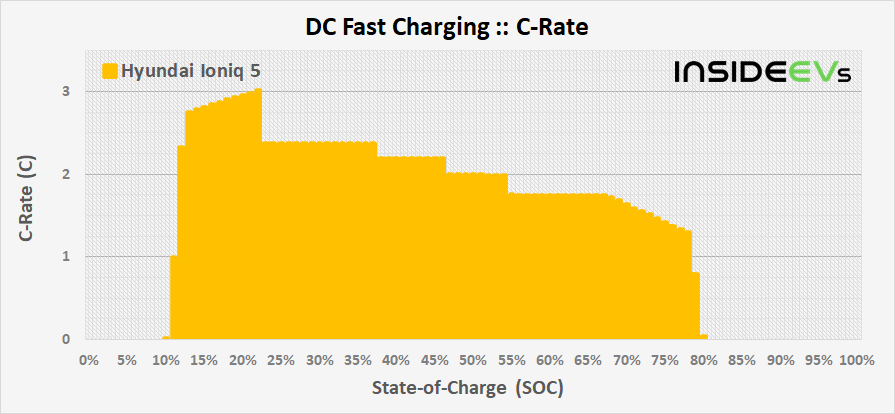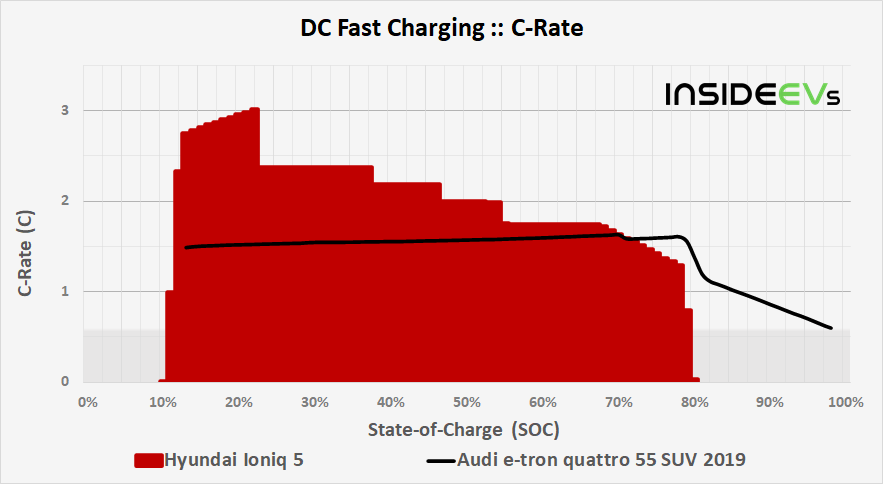Scanning the Internet for information about the Hyundai Ioniq 5, we came across an interesting demonstrative chart of DC fast charging, posted on a German forum - goingelectric.de.
It shows an example of 10-80% SOC charging session, at a 350 kW, 800 V charger.
Hyundai Ioniq 5 charging example (image source: goingelectric.de)

Because the Hyundai Ioniq 5 (and E-GMP-based EVs in general) might be one of the best on the market in terms of fast charging, let's try to analyze this example.
The peak charging power appears to be above 230 kW - probably up to around 235 kW. A really high value.
The power output decreases sharply, but in small steps (at least in the example), and stays above 100 kW up to 80% SOC (end of the session). At this point we don't know how it behaves above 80% SOC.

According to the image, the charging from 10% to 80% SOC took about 18 minutes.
That is in line with Hyundai Motor Group's info:
- 10-80% SOC in 18 minutes (using 800V ultra-fast charger)
- 100 km of range (WLTP) in 4.5 minutes of charge
The average power in the very important range from 20% to 80% SOC appears to be around 147-150 kW (maybe a little bit less), which is 63-65% of the peak value.

Assuming that this is the 77 kWh battery option (72.6 kWh usable), the peak C-rate* - charging power in relation to the total battery capacity - is about 3.0C! That's pretty amazing.
The average C-rate when charging from 20% to 80% SOC is closer to 1.9C, a value normally seen as a peak (if ever) in most of the other models.
*C-rate tells us how the charging power relates to the battery pack capacity. For example: 1C is 1-hour charging power (current), when the power value in kW is equal to the battery pack capacity in kWh. 2C would be enough to recharge in half an hour.
The net battery capacity of 72.6 kWh accounts for about 94% of the total battery capacity.

The rate of replenishing range depends on the energy consumption and the energy consumption depends on the use case.
In the case of Hyundai Ioniq 5 we will assume the WLTP range:
- WLTP
Taking into consideration the WLTP range of 480 km (298 miles) and available battery capacity of 72.6 kWh, we can assume energy consumption of 151 Wh/km (243 Wh/mile).
The effective average speed of range replenishing when charging from 20% to 80% SOC would be then 16 km/minute (10 miles/minute).
The results are outstanding once again. The Hyundai Ioniq 5 has the potential to average at a level that other models usually reach only at peak.
The maximum value is exceeding 25 km/minute (16 miles/minute), which would be in line with what Hyundai-Kia said: "100 km of range (WLTP) in 4.5 minutes of charge".

Comparisons with other EVs

Hyundai IONIQ 5 (2021)

2019 Audi E-Tron
Let's compare those preliminary results with one of the world's best models in terms of DC fast charging - the Audi e-tron quattro 55 (2019 version). At a later point we will probably try to compare it with Tesla, which are also state-of-the-art in terms of charging.
As we can see, for the available SOC range, the Hyundai Ioniq 5 has significantly higher peak power and is above the e-tron for more than half of its SOC, despite the battery pack being 10% smaller (77 vs 95 kWh).
Even then, the difference - up to 80% SOC - is not big. Ultimately, the average between 20-80% is almost the same at nearly 150 kW.
We can't say anything about the area above 80%.

Here is the secret of the Hyundai Ioniq 5 - its battery pack is pushed hard up to around 3.0C, compared to a rather constant load of 1.5C in the case of e-tron.

Finally, the rate of replenishing range. This is where Hyundai Ioniq 5 destroys the Audi e-tron. It not only charges at high power, but is also very efficient. As a result, the range is replenished 30% faster (between 20 and 80% SOC).
On top of that, it has slightly more WLTP range than the e-tron (about 10% or so), which overall translates to a noticeable difference.

A little bit of summary:
| DC Fast Charging Comparison by InsideEVs | ||||||
| Model [data source] |
Drive / Battery (kWh) |
Max Power |
Avg Power (20-80%) |
Max C-Rate |
Avg C-Rate (20-80%) |
WLTP range rep. rate (20-80%) |
| 2019 Audi e-tron quattro 55 SUV [Fastned] |
AWD 95 kWh |
155 kW | 149 kW | 1.6 | 1.6 | 12.4 km/min 7.7 mi/min |
| 2021 Hyundai Ioniq 5 (example) [Forum] |
AWD 77 kWh |
232 kW | 147-150 kW |
3 | 1.9 | 16 km/min 10 mi/min |
The example of DC fast charging session of the Hyundai Ioniq 5 indicates that this will be another level of charging speed - 2C and 15+ km/min on average (20-80% SOC) and 3C/25+ km/min at peak.
Now we eagerly wait for some real world results or data from a reliable source, that would confirm or debunk this example.
| 2021 Hyundai Ioniq 5 (example) :: DC Fast Charging Summary by InsideEVs Battery pack (net / total): 72.6 / 77 kWh [Data source: Forum] |
|
| Peak Power Peak C-rate Average Power (20-80% SOC) |
232 kW 3.0 about 147-150 kW |
| Range Replenishing Speed (Average 20-80% SOC): | |
| WLTP | 16 km/min (10 mi/min) |
General info:
* Some values on the charts are estimated from the data source.
** Temperature of the battery cells might highly negatively affect charging capabilities. We don't have data about temperatures of the battery at the beginning and during the charging process. In cold or hot weather, as well as after driving very dynamically, charging power might be significantly lower than shown on the charts (in extreme cases charging might be impossible until the battery temperature will not return to an acceptable level).
Hyundai Ioniq 5 DC Fast Charging Analysis: It Seems Impressive - InsideEVs
Read More
No comments:
Post a Comment